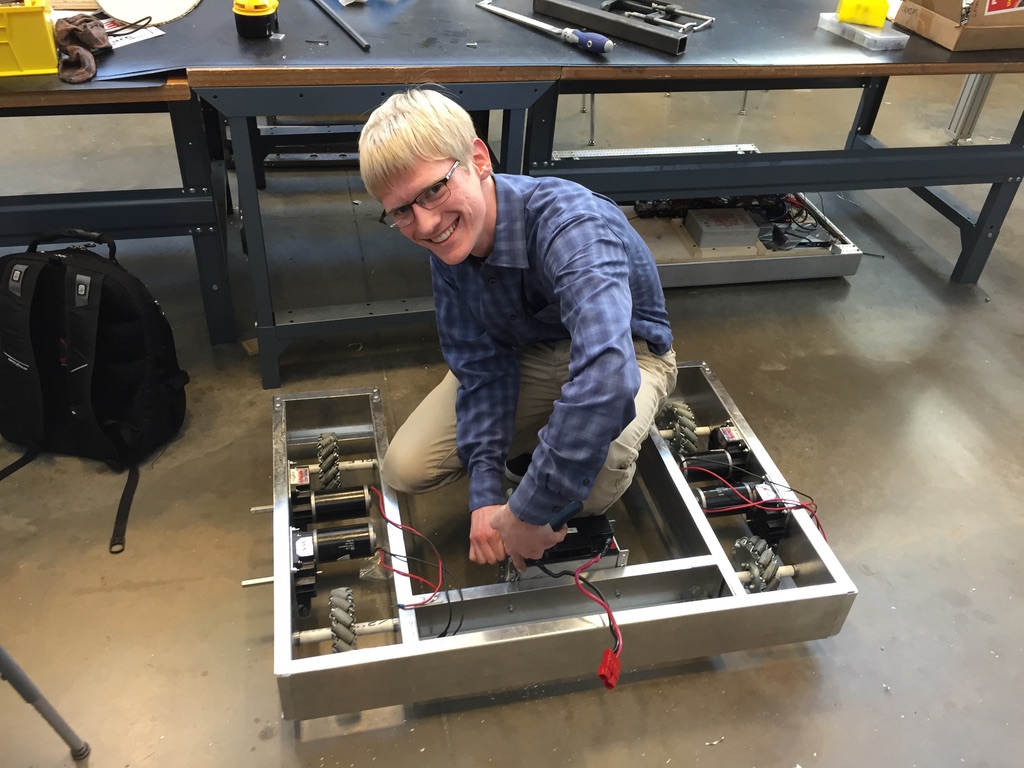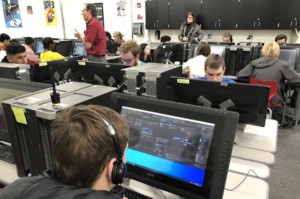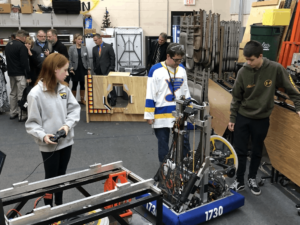Real World Learning: Client Projects Are Trending
Key Points
-
Client projects can be extremely valuable experiences because they engage in real complex organizational problems and develop design thinking, problem-solving, and project management skills.
-
Like internships, they provide immersive career exploration opportunities.
-
Often conducted in teams, client projects build collaboration and leadership skills.

What if you could combine the immersive benefits of an internship with the problem-solving and deliverables production involved in managing a project? You can gain the benefits of both with a client project, the latest learner experience design trend in high school and college education.
Client projects can be extremely valuable experiences because they engage in real complex organizational problems and develop design thinking, problem-solving, and project management skills. Like internships, they provide immersive career exploration opportunities. Often conducted in teams, client projects build collaboration and leadership skills.
Client projects meet or exceed the PBLworks Gold Standard for project design with a couple amped up elements:
- A Challenging Problem or Question is identified by or with a community partner (business or civic) and
- Public Product is not just a presentation, it’s a commitment to delivering value to the client.
Following are two frameworks for client projects in higher education and five groups of examples of high school systems supporting client projects.
Two HigherEd Frameworks for Client Projects
Riipen connects students to employers through real work projects. The venture-backed Canadian edtech startup is bridging the gap between higher education and employment. Students at more than 430 educational institutions work with 28,000 employers on real projects that add value to organizations while developing in-demand skills. Riipen awards badges which are defined by employers and instructors.
The 55 engineering schools that make up the Kern Entrepreneurial Engineering Network (KEEN) share a commitment to developing an entrepreneurial mindset. The KEEN framework adds opportunity recognition and impact delivery to traditional engineering design.
The Rowan College of Engineering had a solid foundation of experiential learning but the KEEN framework added a focus on stakeholders and value creation. After joining KEEN, Rowan students were stimulated to think about designs all the way through. “They are equipped to address why they’re doing the design, understand who it will benefit, and think about the context and impact on various stakeholders.”
Client Projects for High School Learners
DaVinci Schools developed Project Leo, a ChatGPT powered project authoring tool that brings student strengths and interests, industry expertise, and teacher identified needs into the design of personalized projects. Students in the three STEM focused Los Angeles DaVinci high schools use Leo to build 1300 inspiring projects this spring while gaining feedback from teachers, professionals, and peers throughout the process. Through a partnership with Cal Poly, professors and college students give feedback on high school projects and build a professional network in the process.
CAPS Network
When Donna McDaniel opened the Blue Valley Center for Advanced Professional Studies in 2008, it set a new standard for career education. The CAPS team explains, “Students fast forward into their future and are fully immersed in a professional culture, solving real-world problems, using industry-standard tools and are mentored by actual employers, all while receiving high school and college credit.”
Juniors and seniors from five high schools usually attend CAPS in half day blocks where they engage in client projects and entrepreneurial experiences in six strands (eg., bioscience, business, healthcare, engineering).
On my last visit to CAPS in southwest Kansas City, I met three young men building an airplane in the lobby and three young men launching app-based businesses (below).
Corey Mohn took over CAPS leadership in 2014. An entrepreneur turned educator, Mohn saw the opportunity to develop a network of affiliated programs and by 2018 there were dozens of member programs nationwide. The CAPS Network was included in HundrED “most impactful innovations that are changing the face of education in a post-COVID world” and recently added its 100th affilate. (See feature.)
Real World Learning in Kansas City
Also inspired by the success of CAPS, the Kauffman Foundation sponsored Real World Learning initiative in metro Kansas City includes 85 high schools in 35 systems that are adding internships and two kinds of projects:
- Client Projects: Learners analyze and solve authentic problems, working in collaboration with other learners and professionals from industry, nonprofit, civic or community-based organizations. Work involves authentic methods and tools used by professionals in the work environment. Experience includes mentoring and evaluation by working professionals. Output is viewed as value-add by external stakeholders and resume-worthy.
- Entrepreneurial Experiences: Students identify a compelling social or market problem and mobilize resources to research and solve it. Leveraging input and support from multiple stakeholders, students iteratively analyze, prototype, implement, reflect and adapt potential solutions. Outputs of an entrepreneurial experience include a market and stakeholder research summary, a ‘business plan that includes an assessment of costs and benefits associated with the development or operation of their solution, and feedback from relevant external stakeholders obtained through exhibition or ‘shark-tank’ type pitch opportunities
Some client projects are housed in a single course like Drive Projects at Ray-Pec High in English 4. In North Kansas City Schools, client projects are hosted in career pathway blocks.
The Innovation Academy at Basehor-Linwood High was launched as a chance for juniors and seniors to launch self-directed projects and earn core (English, science, social studies) and CTE credits. Guiding principles of the ala carte program include student choice, embracing the unknown, it’s ok to fail, and community partnerships. Last year Innovation Academy opened to freshmen and 45 students had the opportunity to design a park with the city. They engaged the community, considered names, pondered alternative uses, built budgets and developed 3D models. Through deep civic engagement and frequent communication, they earned an English and social studies credit–and they’ll never pass a park again without thinking about the experience they had.
High school students from the Global Impact Academy at Notre Dame de Sion in south Kansas City talk about their trip to Kenya and their impact projects in this podcast. North of Kansas City, students in Liberty EDGE microschool conduct projects aiming at making a world of difference (see feature).
Client Projects at XQ Schools
Founded by Purdue University with support from XQ, the three Indiana campuses of Purdue Polytechnic High School prepare learners for STEM-related postsecondary programs and high-tech careers through a series of client projects.
Every eight weeks, PPHS students are presented a real-world challenge. Project challenges are designed by staff in partnership with industry partners. The projects reflect real-world challenges that Indiana companies face in the areas of healthcare, energy, transportation and philanthropy. Students team up with fellow classmates and work together through a five-step design thinking process to develop a solution. Partners provide guidance on project prototypes, serve as panelists for student presentations and provide feedback on project pitches.
Through project challenges, students learn teamwork, problem-solving, critical thinking, communication and leadership skills, and use a blend of practical STEM applications and traditional liberal arts. It makes for a well-rounded educational experience that teaches students everything they need to know to succeed in school, college and the workforce.
Many of the courses at Iowa BIG feature client projects. The part time high school program in Cedar Rapids, also sponsored by XQ, creates a catalog of core credit opportunities structured as community-connected projects. (See podcast with Trace Pickering.)
World Shaping Projects at Polytechnic
Sabrina Zhang, a student at the Polytechnic School in Pasadena, recently competed in The Earth Prize. Her Agrivision system measures plant health during early, treatable stages to reduce crop losses and organic waste. (See podcast with Sabrina and teacher Jack Prather).
Other Poly students worked with Dr. Bala Selvakumar using molecular biology tools from miniPCR bio to perform experiments on local soil samples and contribute that data to a national database that addresses a global challenge. Students engage hands-on with antibiotic resistance, a challenge recognized by the World Health Organization as a top global public health threat. Dr. Selvakumar noted that any high school can engage with and contribute to this project (see project details).
Employer Provided Innovation Challenges
The U.S. Chamber of Commerce Foundation will be launching the Employer Provided Innovation Challenges (EPIC) initiative this fall. EPIC aspires to scale high-quality work-based learning experiences through a national network of partners that provide authentic, employer-led problem-based learning experiences to high school and postsecondary learners.
EPIC experiences will be hosted by Riipen and badged with Credly. The EPIC initiative will expand access to high quality work-based learning while building a trusted credentialing system to communicate new capabilities.
Afterschool Client Projects
The Knowledge Society is a 10-month youth accelerator program operating in four cities and online. TKS learners work on real problems with global companies and are supported by mentionships, internships, hackathons and a resource rich platform. (See podcast with TKS learners).
Conclusions
Client projects can be challenging to facilitate. They require an external partner involved in multiple steps. They are interdisciplinary by nature and don’t fit cleanly in the typically siloed high school schedule. They usually involve big complicated problems with no simple solutions and assessing learner growth and contribution is challenging.
So why bother? There are at least three reasons to help all learners engage in client projects:
- Client projects offer the most efficient way for learners to experience success in what’s next: diverse teams working on new problems using smart tools. Client projects will increasingly utilize generative AI in solution development allowing learners to experience success as augmented (Super T) professionals.
- Client projects can be super motivating for learners because the work is authentic and interest-aligned with a chance for real contribution.
- Client projects can be an efficient way for employers to support work-based learning and a productive part of student career exploration and pathways.







0 Comments
Leave a Comment
Your email address will not be published. All fields are required.